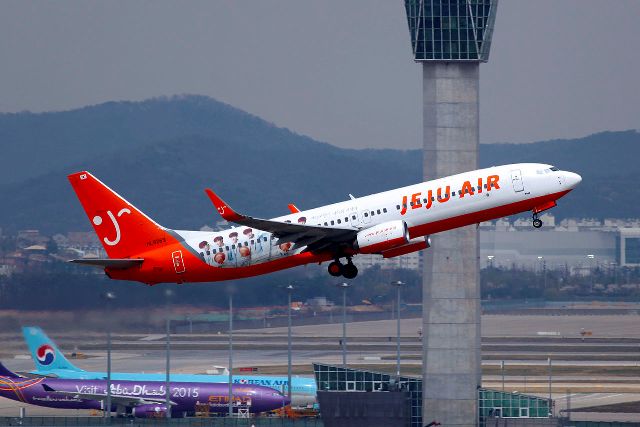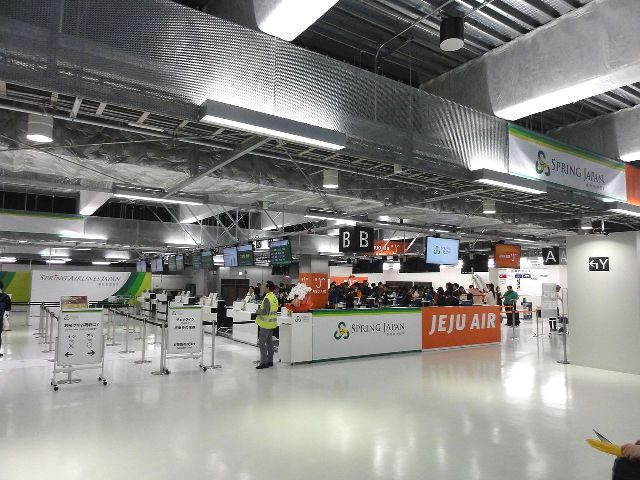| |
 |
|
| ▲ One of Jeju_Air's Boeing 737s takes to the air as the airline posts continued growth. Photo courtesy Byeangel |
Aekyung Industrial’s Jeju Air was co-founded in 2005 as the country’s first low-cost carrier (LLC). At the time, its future was uncertain, but 10 years on and its rise has been as astronomic as the island’s tourism industry.
For the first six months of 2015, in fact, Yonhap reports the LLC smashed records across the board:
First-half operating profits reached 28.8 billion won, a record and 9.5 times 2014 returns;
International and domestic sales were up 22 percent to 286.9 billion won;
A total of 3.26 million passengers flew with them, also an all-time high;
Domestic slight sales jumped 32 percent to 92.9 billion won;
International flight revenue hiked 61 percent to 174.3 billion won.
The numbers are impressive, especially in what has been a tricky year, so let’s take a look back at the flagship carrier’s rise with additional insight from Kim Wonsam, deputy director of Public Relations.
Clear skies after turbulent takeoff
Jeju Air had a rough first six years in the red, says Kim, with “a high exchange rate, high oil price, and checks from rival companies.” The company rose to these challenges, however, and now dominates the domestic market.
According to the Korea Airports Corporation, Jeju Air flies the most domestic routes (four) among Korea’s five LCCs including Jeju-Gimpo (135 times per week) and Jeju-Busan (58 times). Its 13.9 percent share of the 2014 market puts it ahead of Air Busan on 11.7 percent, with the rest below 10 percent.
The company will be aware that sustained growth has always troubled LCCs, and its slender lead is not assured. Future instability could come from its proposed floating on the Korea Exchange (KRX), and it will have to keep up with competing LCCs as they expand international routes to as far as the Hawaiian Islands.
An increased destination range and flight frequency could boost custom and loyalty, enabling ticket prices to remain competitive, which would be good news for fliers. The expansion of the currently saturated Jeju International Airport will only quicken this growth, a significant boon for the company.
| |
 |
|
| ▲ Photo courtesy RSA |
Weaknesses exposed by sudden growth
This rosy outlook is boosted by the addition of Beijing, Taipei and Bangkok to its international routes in 2015. Alongside flights to Hanoi, Manila, Saipan, Guam, Osaka, Qingdao, and Hong Kong, international routes now account for half of its services.
Kim of Public Relations stressed the growth has been recent, with 5.56 million of their 20 million total passengers since inception coming last year, up from 250,000 in 2006.
The sudden growth has exposed some weaknesses. In May, Chosun Ilbo reported how a ticketing error held up over 800 international passengers for up to five hours. Customer service improvement proportional to its new-found market share will thus be an important litmus test.
Will the Chinese cash cow milk forever?
There is a concern that the airline is, much like Jeju tourism, over-reliant on Chinese outbound tourists.
This fragility was brought home with the MERS virus outbreak in May which hit Korean travel badly and Jeju saw layoffs in the tourism industry. As LLCs scrambled to fill cabins, Jeju Air took the lead in giving out “MERS sanitizing kits” at the height of the scare.
The situation was then compounded by the Chinese stock market crash in June. Controlling 80 percent of trade, some 50 million individuals are the chief traders on the Chinese stock market, often the same individuals traveling overseas.
A combination of the MERS scare and a collective tightening of the belts is bad news for Jeju tourism and Jeju Air will have a keen eye on the situation.
Slightly more predictable are the annual typhoons which wreak havoc for regional travel every year. Typhoon Chan-hom passed between Jeju and China in July and Jeju Air swiftly canceled all of its flights, precipitating a rescheduling nightmare.
These unknowns highlight the precarious position for LCCs in the region and Jeju Air must accordingly develop contingency plans to ensure that its financial, logistical, and service networks are prepared to weather such disturbances with minimal losses.
Job creation and corporate responsibility
There is no doubt Jeju Air and the associated tourism growth has boosted the domestic job market in businesses ranging from accommodation and food to transportation and recreation.
Its employee composition, said Kim, is a good indicator of this, expanding from 37 employees in its first year of operation to 1,088 last year, “a 29-fold increase on 2005 and 12.8 times compared to 2006.”
Of 1,088 employees, 272 are located on Jeju and 228 are from Jeju. This is an average local job creation rate of 22.8 jobs per year and 20 percent of the workforce is local.
This is welcome news for locals, but better links with Jeju’s four major universities could improve this performance further by employing young talent with language skills to stimulate the economy, lower unemployment, and improve Jeju Air’s standing in the community.
Environmental responsibilities
Airlines worldwide continue to shirk responsibility for climate change and it is unclear how mass air transit and an expanded airport fit into the province’s plans to be carbon-free by 2030.
If Jeju does become carbon-free, Jeju Air will have to adapt as mass tourism and transportation currently blot Jeju’s environmental record with their associated atmospheric pollution and strain on local infrastructure.
Destination 2020
At a 10th anniversary celebration in Seoul this January, Kim and other executives laid out their ambitious five-year plan which would see a 20-percent increase in sales by 2020 and a total of 60 regular routes being flown by a fleet of 40 aircraft. This would amount to 1.5 trillion won in total sales and 150 billion won in operating profits.
At the same time as expanding its airline services, Jeju Air is also going the same route as other LCCs worldwide and becoming a “network company” that cooperates with travel agencies, car rental companies, hotels, and other leading airlines. This will mean a transformation of its customer service model and pressure on its brand as it accompanies travelers at every stage of their journey.
This balance between specialization and differentiated service, and affordability and quality, is something that other global LCCs have struggled with, and it could be Jeju Air’s main challenge in the years ahead as it seeks to continue its rapid take off and avoid the comfort of cruising on autopilot. |





















